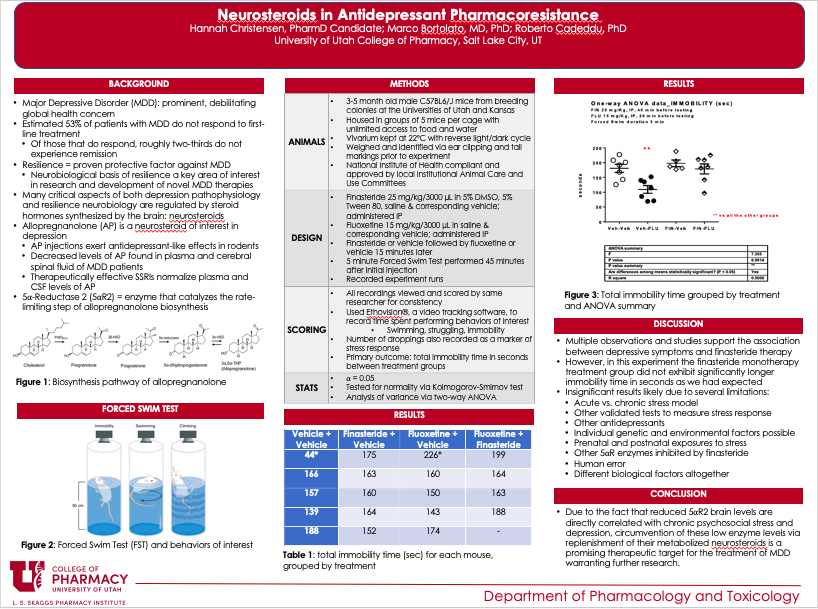Neurosteroids in Antidepressant Pharmacoresistance

Introduction: Major Depressive Disorder (MDD) is a prominent, debilitating global health concern. An estimated 53% of patients with MDD do not respond to first-line treatment (1). Of those that do respond, roughly 67% do not experience remission (1). Clearly, more effective treatment options for MDD are needed. As a proven protective factor against MDD (2-4), the neurobiological basis of resilience is of significant interest in the research and development of novel MDD therapies. Many critical aspects of both depression pathophysiology and resilience neurobiology are regulated by steroid hormones synthesized by the brain called neurosteroids (5-8).
Hypothesis: Administration of the neurosteroid allopregnanolone in adolescent mice with a pharmacologically or genetically induced depressive phenotype will improve observed symptoms of depression better than monotherapy with the first-line antidepressant fluoxetine.
Study Design: one-way ANOVA experimental animal study
Methods: C57BL6/J mice were injected with either finasteride (25 mg/kg, IP) or vehicle, followed by either fluoxetine (15 mg/kg, IP) or vehicle 15 minutes later. All mice were subjected to a 5-minute Forced Swim Test (FST) 45 minutes after the initial finasteride or vehicle injection.
Results: We expect increased immobility times during the FST from mice treated with finasteride. We expect a decrease in total immobility time for mice subsequently treated with allopregnanolone compared to those treated with fluoxetine.
Conclusions: Due to the fact that reduced 5alphaR brain levels are directly correlated with chronic psychosocial stress and depression (9, 10), circumvention of these low enzyme levels via replenishment of their metabolized neurosteroids is a promising therapeutic target for the treatment of MDD.
Published in College of Pharmacy, Virtual Poster Session Spring 2020
Great project! This is really interesting clinically as MDD medications may not be effective for all patients. What an interesting application of finasteride as well. Strong work!
Thank you for the interesting study! Do you think 45 minutes is enough time to assess some of the pharmacologic effects? From practice, pharmacokinetic onset may take short term effect, however long term pharmacodynamic changes from these agents may be what impacts depression? Do you think if you were to do this particular test after 4-6 weeks of finasteride vs fluoxetine exposure there would be a difference? Thank you!
Thanks – in previous preliminary studies the Bortolato lab found 45 minutes to be enough time to show a response, though it is acknowledged that this experiment better models acute stress since a test was needed for quick throughput. It’s possible the results would be different with an experiment and timeframe that is more in line with chronic depression.
Hannah, nicely presented work! I enjoyed reading your poster and learning about the project more. I’m a bit unclear about the relation between the data in the table and that in the figure. They seem different to me (different numbers/group, different values). Can you clarify how they relate to each other?
Thanks Dr. Keefe, the Bortolato lab repeated the experiment with a greater number of mice/group which is depicted in the figure so that’s why there are differences compared to the results of my initial run shown in the table.
Hello Hannah – congratulations on tackling this difficult project. You sailed through and were able to present the project in an interesting manner. Happy Graduation!!
Thanks so much Dr. Shane-McWhorter!